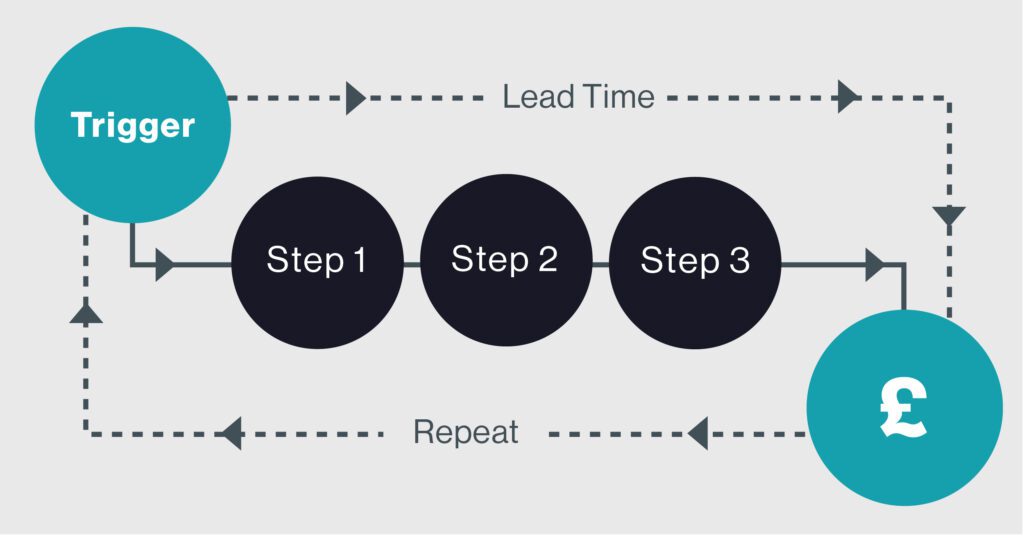Companies are organising the work in many different ways to optimise the value they provide for their customers and how they deliver work. Increasingly, some of our customers are moving toward value stream management. You may wonder what that might look like for your business.
One of the most effective ways to demonstrate this is by answering the following question: How do you identify, build and organise a value stream?
Identifying a value stream can be challenging. They will be different for every enterprise, and there’s no magic number regarding how many you should have.
It’s all about adding value for the customer and delivering that in the most efficient way possible.
How Do You Identify A Value Stream?
Reasons why your business does things = to add value to your customers.
You can group all the activities that drive the production of your end product or service into value streams.
It’s all about your unique value propositions. Where does your business want to lead or excel over competitors? What value do you want to provide for the end customer – whether that’s an internal stakeholder or an external customer?
For a bank, a good example could be building the most efficient, secure banking app on the market. You want to ensure that your customers have a simple, easy-to-use interface and can effortlessly access all the features they need in a way that keeps their personal data secure. You may also want to provide features that other rival banking apps currently don’t provide.
To help you choose the right value streams, you will always need to go back to your business values and be confident that your customers will find value in these products or initiatives.
When defining your value streams it’s important to constantly reassess and insure that what you’re providing is still relevant to your customers and aligns to your overall strategic objectives.
How Do You Build & Organise A Value Stream?
Lead time is a key element of organising your value stream. The focus should be to reduce time-to-market as much as possible, without compromising on the end value.
Breaking down the components of a new product or initiative, you’ll want to split your value streams into development and operational.
The development part comes first.
Development Value Streams:
The sequence of activities and people needed to convert a business hypothesis into a technology-enabled solution that delivers customer value. An example for a bank could be to build a banking app or website that customers can use to access your services and support remotely.
Operational Value Streams:
The sequence of activities and people needed to deliver a product or service to a customer. For a bank, an example could be providing a loan or something a little more abstract, such as delivering a professional service.
These are more service-based initiatives as opposed to product ones.
Mapping Out Your Value Streams:
When mapping out your value stream, all of the activities that are needed to build the end product or solution can be placed into a line. Think of it as getting from A to B. It’s important not to overlook any of the steps as this will form the groundwork of your strategic review.
Once this is done, it’s time to cast a critical lens over each of the steps. The questions to ask include:
- Does my customer care about this?
- Will this contribute to customer satisfaction?
- Is this integral to the business values?
- Is there any projected monetary value in including this step?
If any of the stages receive a negative response, then you can challenge the step. Rethink how it could be removed from the process or altered for enhanced efficiency.
An example could be a food supplier that sells ready meals. If you chop vegetables by hand, a task that takes considerable time and resources and is not attached to your business values or customer satisfaction, you could remove this part of the process. Instead, you could chop the vegetables with machines or buy them pre-chopped.
This is an effective practice to reduce your lead time while providing optimal value for the end customer.
The value will be placed at the end of your stream map, and at the start will be the trigger. The time it takes to complete all the steps between the trigger and the end value is your lead time.

How Can Software Help With This?
In an era of digital transformation, businesses are increasingly looking for enhanced operational efficiency. Moving away from paperwork or documents placed on disparate systems is a crucial part of this.
PPM software solutions enable you to bring everything together under one digital roof. This can be accessed by everyone on your team, from PMOs to chief executives and stakeholders. You’re in control of the visibility parameters for confidential information and high level data reports.
Software, such as Clarity, allows its customers to visualise their whole portfolio of work in ways that can easily provide traceability from strategy to execution. In the example below, work has been organised into value streams and we can easily see how those value streams are progressing and how they feed into the ongoing strategy of the business.

Value stream management cannot be implemented effectively without the right tools. If you want to act on the change effectively and sustain it for the long-term, tools such as Clarity and Rally are vital. They’re built for agility.
When your business is going through a digital transformation and rethinking how you work, that will also require a great deal of strategising. Partnering with PPM software experts, such as Ignite Technology, can make all the difference.
Not only can a consultant reduce the time it takes to implement value stream management software, but they’ll also make sure your business is getting the optimum ROI.




